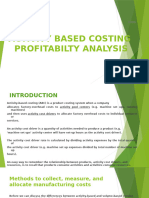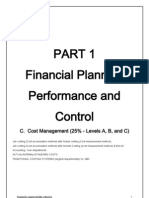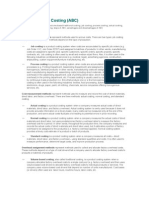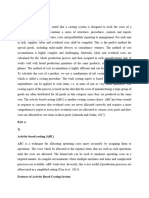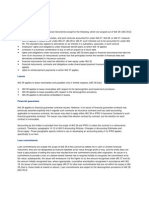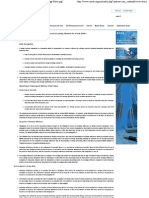Abc Report Script
Abc Report Script
Uploaded by
Kim DedicatoriaCopyright:
Available Formats
Abc Report Script
Abc Report Script
Uploaded by
Kim DedicatoriaOriginal Title
Copyright
Available Formats
Share this document
Did you find this document useful?
Is this content inappropriate?
Copyright:
Available Formats
Abc Report Script
Abc Report Script
Uploaded by
Kim DedicatoriaCopyright:
Available Formats
STRATEGIC ROLE OF ABC
Activity-based costing (ABC) is a method for determining accurate costs. While ABC is a relatively recent innovation in cost
accounting, it is rapidly being adopted by companies across many industries and within government and not-for-profit organizations.
The solution is to use activity-based costing to charge these indirect costs to the products, using detailed information on the activities
that make up the indirect costs—inspection, fabric cutting, and materials handling.
ROLE OF VOLUME BASED COSTING
The ABC approach is often preferred: the volume-based approach will cause significant inaccuracies in the product costs—some
products will be overcosted and others undercosted because the usage of activities is not in proportion to the volume of output.
Before discussing activity-based costing, we need to define several important terms to further understand ABC.
TWO STAGE COST ASSIGNMENT
A two-stage cost assignment procedure assigns resource costs such as factory overhead costs to activity cost pools and
then to cost objects to determine the amount of resource costs for each of the cost objects.
Volume-based costing systems assign factory overhead costs first to plant or departmental cost pools and second to products or
services Volume-based systems, in the first stage, charge factory overhead costs to a single plant cost pool or to departmental cost
pools. This approach is convenient and simple, because many accounting systems in use today accumulate cost information by
department, which is easily aggregated to the plant level. In the second stage, a volume-based rate (based on units produced or hours
used in production) is then used to apply overhead to each of the cost objects. A volume-based two-stage cost assignment procedure,
however, is likely to distort product or service costs. This is true especially in the second stage where the volume-based costing system
uses a cost driver such as direct labor-hours or output units to assign factory overhead costs. Because all products or services do not
usually consume factory overhead resources in proportion to the volume-based measure the firm uses to assign factory overhead costs,
a volume-based system often leads to inaccurate measures for the costs of support activities in its operations. This distortion becomes
more serious when a substantial portion of factory overhead costs is not output-volume related and the firm manufactures a diverse
mix of products with differences in volumes, sizes, or complexities. Activity-based costing systems differ from volume-based costing
systems by linking uses of resources to activities and linking activity costs to products, services, or customers (see Exhibit 5.2). The
first stage assigns factory overhead costs to activities by using appropriate resource consumption cost drivers. The second stage
assigns the costs of activities to
cost objects using appropriate activity consumption cost drivers that measure the demands cost objects place on the activities. By
using cost drivers in both the first and second stage cost assignments, activity based costing systems provide more accurate measures
of product or service costs for the cost of activities that are not proportional to the volume of outputs produced. In summary, activity-
based costing systems differ from volume-based costing systems in two ways. First, the ABC system defines cost pools as activities
rather than production plant or department cost centers. Second, the cost drivers that the ABC system uses to assign activity costs to
cost objects are drivers based on an activity or activities performed for the cost object. The volume-based approach uses a volume-
based cost driver that often bears little or no relationship to the consumption of resource costs by the cost objects.
BENEFITS OF ABC
1. Better profitability measures. ABC provides more accurate and informative product costs, leading to more accurate product and
customer profitability measurements and to better-informed strategic decisions about pricing, product lines, and market segments.
2. Better decision making. ABC provides more accurate measurements of activity-driving costs, helping managers to improve
product and process value by making better product design decisions, better customer support decisions, and fostering value-
enhancement projects.
3. Process improvement. The ABC system provides the information to identify areas where process improvement is needed.
4. Cost estimation. Improved product costs lead to better estimates of job costs for pricing decisions, budgeting, and planning.
5. Cost of unused capacity. Since many firms have seasonal and cyclical fluctuations in sales and production, there are times when
plant capacity is unused.
ABC systems provide better information to identify the cost of unused capacity and maintain a separate accounting for this cost.
COMPARISON OF VOLUME-BASED AND ACTIVITY-BASED COSTING
The following example contrasts the volume-based costing system using direct labor-hours as the cost driver with an activity-based
costing system that uses both volume-based and activity-based cost drivers.
CUSTOMER PROFITABILITY ANALYSIS
A good understanding of the profitability of a firm’s current and potential customers can help firms to improve overall profits and to
become more competitive. This begins with an analysis of the cost to serve the customer.
CUSTOMER PROFITABILITY ANALYSIS
Customer profitability analysis provides valuable information to the assessment of customer value.
CUSTOMER LIFETIME VALUE
Present value is used because the profits from the customer are expected to continue for a number of years. To provide a more
comprehensive and strategically relevant measure of the value of the customer, CLV takes into account the company’s expectations
about the future potential growth in profits for a customer.
CUSTOMER EQUITY
Value equity- give example.
While all three drivers of customer equity are important, studies have shown that the relative importance of the drivers varies from
industry to industry
CLV and CE are most appropriate where the customers are the ultimate consumer of the product. This is called a B2C (a business to
customer relationship), in contrast to a B2B relationship (business to business). In a B2B relationship, the customer relationship is
maintained in a different way, and the issues of brand equity and retention do not apply.
Implementation Issues and Extensions
A successful ABC/M implementation requires close cooperation among management accountants, engineers, and manufacturing and
operating managers. They need to act as a team in identifying activities, cost drivers, and requisite information, both financial and
nonfinancial.
Multistage Activity-Based Costing
In practice, because of a firm’s complexity due to the diversity of its products, services, and manufacturing or operating processes,
some activities are intermediate cost objects for other activities while others are assigned directly to cost objects. To capture and
calculate accurately the costs for this complexity, some firms use multistage activity-based costing.
EXHIBIT 5.21
The exhibit illustrates how a total of $70 of resource costs are assigned in multistage ABC costing. After multistage allocations, $25 is
assigned to products, $20 is assigned to customer related activities, and $25 is assigned to infrastructure-related costs (computer
equipment and software, buildings, and other equipment, etc.).
Resource Consumption Accounting (RCA)
Another resource-centric approach to the implementation of large ABC costing systems is based on the idea that the common element
in the utilization of activities is the unit of time. When a substantial amount of the cost of a company’s activities are in a highly
repetitive process (much like in the RCA example above), the cost assignment can be based on the average time required for each
activity.
Time-driven activity-based costing (TDABC) assigns resource costs directly to cost objects using the cost per time
unit of supplying the resource, rather than first assigning costs to activities and then from activities to cost objects
You might also like
- My Maid Invest Ebook by Bo SanchezDocument27 pagesMy Maid Invest Ebook by Bo SanchezSherwin Sabado100% (3)
- 9-25 Variable Versus Absorption Costing. The Zeta Company Manufactures Trendy, GoodDocument3 pages9-25 Variable Versus Absorption Costing. The Zeta Company Manufactures Trendy, GoodElliot Richard100% (1)
- Inventory Management SystemDocument3 pagesInventory Management SystemAkash DherangeNo ratings yet
- The Strategic Role of Activity-Based CostingDocument2 pagesThe Strategic Role of Activity-Based CostingDabelisthaNo ratings yet
- Traditional Costing Systems and ActivityDocument8 pagesTraditional Costing Systems and ActivityMisganaw MekonnenNo ratings yet
- ABC Costing (1) CostDocument17 pagesABC Costing (1) CostMuhammad BilalNo ratings yet
- Chapter VI Lecture NoteDocument14 pagesChapter VI Lecture NotegereNo ratings yet
- Abc SummaryDocument2 pagesAbc SummaryJana RaoNo ratings yet
- Summary Activity Based CostingDocument4 pagesSummary Activity Based CostingliaNo ratings yet
- 2024 Activity Based Costing and ManagementDocument12 pages2024 Activity Based Costing and Managementwambualucas74No ratings yet
- Chapter 5 NotesDocument6 pagesChapter 5 NotesXenia MusteataNo ratings yet
- ABCDocument13 pagesABCSunil Bodo RaitoNo ratings yet
- Class 4Document7 pagesClass 4carlaNo ratings yet
- Part - 3 - Abc CostingDocument7 pagesPart - 3 - Abc CostingDaniel BalchaNo ratings yet
- What Is 'Activity-Based Costing (ABC) 'Document2 pagesWhat Is 'Activity-Based Costing (ABC) 'komal komalNo ratings yet
- Chapter Five Lecture NoteDocument15 pagesChapter Five Lecture NoteAbrha636No ratings yet
- Part - 3 - ABC CostingDocument14 pagesPart - 3 - ABC CostingDaniel BalchaNo ratings yet
- Activity Based Coting ExamplesDocument14 pagesActivity Based Coting ExamplesMuhammad azeem100% (1)
- What Is ActivityDocument20 pagesWhat Is ActivityShobhit ShuklaNo ratings yet
- Unit - 9 Modern Methods of Management AccountingDocument18 pagesUnit - 9 Modern Methods of Management AccountingAayushi KothariNo ratings yet
- Activity Based Costing (Abc) Profitability AnalysisDocument19 pagesActivity Based Costing (Abc) Profitability Analysismalcolmmcnab139No ratings yet
- Activity Based CostingDocument4 pagesActivity Based CostingPetar BojovicNo ratings yet
- Roikhanatun Nafi'Ah, Activity Based Costing SummaryDocument3 pagesRoikhanatun Nafi'Ah, Activity Based Costing SummaryRoikhanatun Nafi'ahNo ratings yet
- Strategic Cost Accounting M. Com (Semester IV) Topic-Activity Based CostingDocument8 pagesStrategic Cost Accounting M. Com (Semester IV) Topic-Activity Based CostingDarshi PancholiNo ratings yet
- Activity Based Costing (ABC)Document9 pagesActivity Based Costing (ABC)Karan SoniNo ratings yet
- Activity Based Costing SystemDocument6 pagesActivity Based Costing SystemZoya KhanNo ratings yet
- Fourth Meeting - COST ASSIGNMENT AND ACCOUNTING ENTRIESDocument11 pagesFourth Meeting - COST ASSIGNMENT AND ACCOUNTING ENTRIESsagung anindyaNo ratings yet
- ABC Lecture NotesDocument8 pagesABC Lecture Notessudeis omaryNo ratings yet
- ABC CostingDocument4 pagesABC CostingKashif GulzarNo ratings yet
- U04 Cost Accumulation SystemDocument30 pagesU04 Cost Accumulation SystemIslam AhmedNo ratings yet
- ABC Cma ProjectDocument5 pagesABC Cma ProjectAakash BhotikaNo ratings yet
- Activity Based CostingDocument10 pagesActivity Based CostingMohd SajidNo ratings yet
- Activity Based Cosing Assignment PDFDocument73 pagesActivity Based Cosing Assignment PDFAjinkya ChincholeNo ratings yet
- CostingDocument26 pagesCostingMyo ThazinNo ratings yet
- AB Costing (Industry) AhmedDocument13 pagesAB Costing (Industry) AhmedBuy SellNo ratings yet
- ABC NotesDocument4 pagesABC NotessibusisoNo ratings yet
- What Is Activity Based CostingDocument3 pagesWhat Is Activity Based CostingAj LeeNo ratings yet
- Activity Based CostingDocument7 pagesActivity Based CostingAnonymous IpnRP293No ratings yet
- Activity-Based Costing Usage and Pitfalls PDFDocument6 pagesActivity-Based Costing Usage and Pitfalls PDFWilly BaronNo ratings yet
- Lesson 6-Activity Based Costing SystemDocument11 pagesLesson 6-Activity Based Costing SystemOmotayo OpeniyiNo ratings yet
- Activity Based Costing (ABC) : Cost & Management AccountingDocument14 pagesActivity Based Costing (ABC) : Cost & Management AccountingUrooj MustafaNo ratings yet
- Chapter 5 Activity Based Costing and Activity Based ManagementDocument69 pagesChapter 5 Activity Based Costing and Activity Based Managementkhushboo100% (2)
- 13.target Costing & Activity Based CostingDocument5 pages13.target Costing & Activity Based Costingmercatuz50% (4)
- Activity Based CostingDocument11 pagesActivity Based Costingamar92470% (1)
- The Traditional Costing SystemDocument3 pagesThe Traditional Costing SystemMuhd FadhilNo ratings yet
- Citeseerx - Ist.psu - Edu Viewdoc Download Doi 10.1.1.203Document15 pagesCiteseerx - Ist.psu - Edu Viewdoc Download Doi 10.1.1.203MeraSultanNo ratings yet
- Activity Based CostingDocument9 pagesActivity Based CostingAmitNo ratings yet
- Activity-Based CostingDocument2 pagesActivity-Based CostingbabyNo ratings yet
- ABC ShortDocument3 pagesABC Shortsunil.ctNo ratings yet
- ABC - 07,13,17,28 NewDocument85 pagesABC - 07,13,17,28 NewNavneet NandaNo ratings yet
- Costing SystemDocument12 pagesCosting Systemshahadathossain6151No ratings yet
- TempDocument28 pagesTempKIMBERLY MUKAMBANo ratings yet
- ACC 301 ABC SystemDocument23 pagesACC 301 ABC SystemThomas nyadeNo ratings yet
- Using Activity Based Costing in Service Industries.: Cost AllocationsDocument7 pagesUsing Activity Based Costing in Service Industries.: Cost AllocationsWaqar AkhtarNo ratings yet
- StrengthDocument4 pagesStrengthWilly BaronNo ratings yet
- 503 ABC Module Fa14Document16 pages503 ABC Module Fa14irquadriNo ratings yet
- FinalDocument7 pagesFinallayansafsouf1No ratings yet
- Activity-Based Costing (ABC)Document4 pagesActivity-Based Costing (ABC)Dach GamersNo ratings yet
- Chapter 2. - Activity Based Costing PPT Dec 2011Document5 pagesChapter 2. - Activity Based Costing PPT Dec 2011shemidaNo ratings yet
- ABC and ABMDocument7 pagesABC and ABMKanwalNo ratings yet
- Benefit and Limitation of Active Based Costing (ABC)Document1 pageBenefit and Limitation of Active Based Costing (ABC)smmnorNo ratings yet
- Costing Assignment 1 Report 2020Document7 pagesCosting Assignment 1 Report 2020rachel 1564No ratings yet
- Shareholder Wealth Maximization and Social Welfare:: A Utilitarian CritiqueDocument26 pagesShareholder Wealth Maximization and Social Welfare:: A Utilitarian CritiqueKim DedicatoriaNo ratings yet
- Shareholder Wealth Maximization and Social WelfareDocument18 pagesShareholder Wealth Maximization and Social WelfareKim DedicatoriaNo ratings yet
- The Assumption of MaryDocument2 pagesThe Assumption of MaryKim DedicatoriaNo ratings yet
- Written Report LawDocument2 pagesWritten Report LawKim DedicatoriaNo ratings yet
- Gail S. Dedicatoria Bsa Ii-CDocument2 pagesGail S. Dedicatoria Bsa Ii-CKim DedicatoriaNo ratings yet
- Activity-Based Costing and Customer Profitability AnalysisDocument44 pagesActivity-Based Costing and Customer Profitability AnalysisKim DedicatoriaNo ratings yet
- Product and Brand Management: BY: Kedareswar Panda Faculty Marketing & Soft SkillDocument283 pagesProduct and Brand Management: BY: Kedareswar Panda Faculty Marketing & Soft SkillReetanjali Naik100% (1)
- National Stock Exchange'S Certification in Financial Markets (NCFM)Document4 pagesNational Stock Exchange'S Certification in Financial Markets (NCFM)hitekshaNo ratings yet
- The Consumer Behaviour Towards Online Shopping in TiruchirappalliDocument19 pagesThe Consumer Behaviour Towards Online Shopping in TiruchirappalliSababathiNo ratings yet
- Cooper Case Study: Deeksha Kamath (34) Esha Khurana (39) Garima NaharDocument9 pagesCooper Case Study: Deeksha Kamath (34) Esha Khurana (39) Garima NaharBithal Ansuman100% (1)
- Animal Feed Project ProposalDocument41 pagesAnimal Feed Project ProposalAlgamber MahiNo ratings yet
- Chapter 16 Managing Productivity and Marketing EffectivenessDocument16 pagesChapter 16 Managing Productivity and Marketing Effectivenessangelicaf.kmcastilloNo ratings yet
- Ias 39Document11 pagesIas 39Muhammad Qasim FareedNo ratings yet
- Shared Services As A New Organizational Form (Tanya Bondarouk) (Z-Library)Document232 pagesShared Services As A New Organizational Form (Tanya Bondarouk) (Z-Library)David MagalhaesNo ratings yet
- WEB906875211Document3 pagesWEB906875211gzan antonyNo ratings yet
- Tetra Pack Sugarcane JuiceQDocument21 pagesTetra Pack Sugarcane JuiceQapekshaankolekar100% (1)
- Coach Inc: Ceo-Rahmenta Bernard Board Members - Dan Mcgovern, Anthony Ayala, Mike Pierre-LouisDocument26 pagesCoach Inc: Ceo-Rahmenta Bernard Board Members - Dan Mcgovern, Anthony Ayala, Mike Pierre-Louismohidul islamNo ratings yet
- Micro ResearchDocument31 pagesMicro ResearchangeluNo ratings yet
- MObile InvoiceDocument1 pageMObile Invoicechandra kiran KodavatiNo ratings yet
- WinMoreFX 2024 MentorshipDocument40 pagesWinMoreFX 2024 MentorshipDaniel EduahNo ratings yet
- MASB6 The Effects of Change2Document2 pagesMASB6 The Effects of Change2hyraldNo ratings yet
- Hidesign Market PositioningDocument14 pagesHidesign Market PositioningVennam Anand100% (1)
- Sport Obermeyer CaseDocument2 pagesSport Obermeyer CaseklubnikaN69% (13)
- Introduction To Sales ManagementDocument105 pagesIntroduction To Sales ManagementSanghamitra DasNo ratings yet
- Chapter 1: Money, Banking, and Financial MarketsDocument11 pagesChapter 1: Money, Banking, and Financial MarketsKerby Gail RulonaNo ratings yet
- (Lehman Brothers) Quantitative Credit Research Quarterly - Quarter 1 2007Document71 pages(Lehman Brothers) Quantitative Credit Research Quarterly - Quarter 1 2007carminatNo ratings yet
- Millionaire Forex Trader Secrets PDFDocument56 pagesMillionaire Forex Trader Secrets PDFin_angel030% (1)
- The Impact of Labor Supply, Population, and Wages On Prices of Basic CommoditiesDocument23 pagesThe Impact of Labor Supply, Population, and Wages On Prices of Basic CommoditiesDanielyn GestopaNo ratings yet
- Strategi Omnichannel Steve MaddenDocument2 pagesStrategi Omnichannel Steve MaddenCha IndraNo ratings yet
- PL - 6Document3 pagesPL - 6Abdulla An NomanNo ratings yet
- Tata Power - FNO AnalysisDocument19 pagesTata Power - FNO AnalysisritomdNo ratings yet
- Tradable Banks Index Based On Free-Float and Impact CostDocument22 pagesTradable Banks Index Based On Free-Float and Impact CostShahid Ur RehmanNo ratings yet
- Welcome To VALSDocument3 pagesWelcome To VALSdedu1957No ratings yet




















